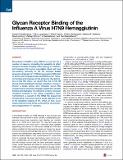Glycan Receptor Binding of the Influenza A Virus H7N9 Hemagglutinin
Author(s)
Tharakaraman, Kannan; Jayaraman, Akila; Raman, Rahul; Viswanathan, Karthik; Stebbins, Nathan W.; Johnson, David Alan; Shriver, Zachary H.; Sasisekharan, Ram; Stebbins, Nathan W.; Sasisekharan, Viswanathan; ... Show more Show less
DownloadSasisekharan_Glycan receptor.pdf (1.582Mb)
PUBLISHER_CC
Publisher with Creative Commons License
Creative Commons Attribution
Terms of use
Metadata
Show full item recordAbstract
The advent of H7N9 in early 2013 is of concern for a number of reasons, including its capability to infect humans, the lack of clarity in the etiology of infection, and because the human population does not have pre-existing immunity to the H7 subtype. Earlier sequence analyses of H7N9 hemagglutinin (HA) point to amino acid changes that predicted human receptor binding and impinge on the antigenic characteristics of the HA. Here, we report that the H7N9 HA shows limited binding to human receptors; however, should a single amino acid mutation occur, this would result in structural changes within the receptor binding site that allow for extensive binding to human receptors present in the upper respiratory tract. Furthermore, a subset of the H7N9 HA sequences demarcating coevolving amino acids appears to be in the antigenic regions of H7, which, in turn, could impact effectiveness of the current WHO-recommended prepandemic H7 vaccines.
Date issued
2013-06Department
Massachusetts Institute of Technology. Department of Biological Engineering; Singapore-MIT Alliance in Research and Technology (SMART); Koch Institute for Integrative Cancer Research at MITJournal
Cell
Publisher
Elsevier B.V.
Citation
Tharakaraman, Kannan, Akila Jayaraman, Rahul Raman, Karthik Viswanathan, Nathan W. Stebbins, David Johnson, Zachary Shriver, V. Sasisekharan, and Ram Sasisekharan. “Glycan Receptor Binding of the Influenza A Virus H7N9 Hemagglutinin.” Cell 153, no. 7 (June 2013): 1486–1493. © 2013 Elsevier B.V.
Version: Final published version
ISSN
00928674